10. Sample Returns
This chapter shows how two sole proprietors fill out their income tax returns. Susan J. Brown reports her net profit from her business on Schedule C. She cannot use Schedule C-EZ. Stanley Price reports his net profit from his business on Schedule C-EZ.
Preparing the Return for Susan J. Brown
Susan J. Brown owns and operates Family Fashions, a ready-to-wear clothing shop. She uses an accrual method of accounting and files her return on a calendar year basis.
Five employees worked in her shop during the year. She filed all the necessary employment tax forms and made the required tax deposits. See Publication 15, Circular E, Employer's Tax Guide.
Schedule C
First, Susan fills in the information required at the top of Schedule C. She starts by entering her name and social security number. Then she completes lines A through H.
Line A. She enters her principal business.
Line B. She enters 448140, which is the 6-digit business code for a family clothing shop. She found the code on page C-8 of the instructions for Schedule C. Susan locates the major business category that describes her business. She reads down the items under Retail Trade to find 448140 - Family clothing stores.
Line C. She enters the name of her business - Family Fashions.
Line D. She enters her employer identification number (EIN). She has to have an EIN because she has employees. For information about EINs, see Identification Numbers in chapter 1.
Line E. She enters her business address.
Line F. She checks box 2 for accrual method of accounting.
Line G. Susan checks Yes because she materially participated in her business during the year. The material participation rules are explained in the instructions for Schedule C.
Line H. She leaves the box blank because she did not start or acquire her business during the year.
Part I - Income and Part III - Cost of Goods Sold
Susan enters items of income in Part I.
Line 1. Susan enters her total sales of $410,000 for the year.
Line 2. She enters the refunds she gave on merchandise her customers returned, as well as other adjustments she made to customers' purchases. They total $1,442.
Line 4. Susan uses Part III on page 2 of Schedule C to figure her cost of goods sold.
Part III, line 35. Her inventory at the beginning of the year, $42,843, is the same as her inventory at the end of last year. This figure matches the amount on Part III, line 41, of her last year's Schedule C.
Part III, line 36. The total cost of goods she bought to sell to customers, minus the cost of the goods she returned to her suppliers, was $241,026. From this stock, she withdrew clothing and accessories for her own use that cost $774. She subtracts the cost of these items from her total purchases to figure net purchases of $240,252.
Part III, line 40. She adds her net purchases to her beginning inventory. This sum is the total goods Susan had available for sale during the year.
Part III, line 41. Susan's inventory at the end of the year was $43,746.
Part III, line 42. Susan subtracts her inventory at the end of the year (line 41) from the goods that were available for sale (line 40) to get the cost of goods sold during the year. For more information on inventories, see chapter 2. For more information on cost of goods sold, see chapter 6.
Line 5. Susan's gross profit, $169,209, is the difference between her net sales (line 3) and the cost of goods sold (line 4).
Line 7. Because Susan did not have any income to report on line 6, the gross income is the same as the gross profit (line 5).
Part II - Expenses
Susan enters her expense items in Part II.
Line 8. Susan paid $3,500 for ads.
Line 9. During the year, Susan determined that she would not be able to collect $479 from bad checks and deducted this amount as bad debts. See Bad Debts in chapter 8.
Line 10. She used her van 75% for business during the year. She spent a total of $3,000 for gas and oil. She can deduct 75% of $3,000 or $2,250 for gas and oil. Other van expenses include $713 (75% of $950) for insurance, $812 (75% of $1,083) for repairs and upkeep, and $75 (75% of $100) for tags. She enters the total, $3,850, on line 10. See Car and Truck Expenses in chapter 8.
Line 13. Susan enters the $4,277 depreciation from Form 4562, discussed later.
Line 15. Susan's $238 deduction is for insurance on her business property (van insurance is included in line 10). The deduction is only for premiums that give her coverage for the year. See Insurance in chapter 8.
Line 16b. Susan had borrowed money to use in her business. The interest on these loans was $2,633 for the year. See Interest in chapter 8.
Line 18. The $216 Susan paid for postage during the year is her only office expense.
Line 20b. Her rent for the store was $1,000 a month, or $12,000 for the year. See Rent Expense in chapter 8.
Line 21. She had her store counters refinished and other painting done at a total cost of $964.
Line 22. She spent $1,203 on supplies.
Line 23. Susan renewed her business license and paid property tax on her store fixtures. She also paid the employer's share of social security and Medicare taxes for her employees and paid state and federal unemployment taxes. She enters the total of all these taxes, $5,727, on this line. See Taxes in chapter 8.
Line 25. Susan's total expense for heat, light, and telephone for the year is $3,570.
Line 26. Susan paid her employees a total of $59,050 for the year. She does not include in wages any amounts she paid to herself or withdrew from the business for her own use. See Employees' Pay in chapter 8.
Line 27. Susan enters the total of her other business expenses on this line. These expenses are not included on lines 8-26. She lists the type and amount of the expenses separately in Part V of page 2, and carries the total entered on line 48 to line 27. See chapter 8 for expenses you can or cannot deduct.
Line 28. Susan adds all her deductions listed in Part II and enters the total on this line.
Line 29. She subtracts her total deductions (line 28) from her gross income (line 7). Susan has a tentative profit of $63,424.
Line 30. Susan did not use any part of her home for business, so she does not make an entry here. For information about business use of the home, see Business Use of Your Home in chapter 8.
Line 31. Susan has a net profit of $63,424 ( line 29 minus line 30). She enters her net profit here, on line 12 of Form 1040, and on line 2, Section A of Schedule SE (Form 1040).
Line 32. Susan does not have a loss, so she skips this line. If she had a loss and she was not at risk for all her investment in the business, the amount of loss she could enter on line 12 of Form 1040 might be limited. For an explanation of an investment at risk, see the Schedule C instructions for line 32.
Form 4562 - Depreciation and Amortization
Susan figures her depreciation for the year on Form 4562.
Lines 1 through 13. On May 19, Susan bought a $200 adding machine and placed it in service on that same day. She chose to deduct its cost as a section 179 deduction. See Depreciation in chapter 8.
Line 16. Susan enters $1,117 for depreciation on assets she purchased before 1987. For items bought after 1980 and before 1987, she uses the regular Accelerated Cost Recovery System (ACRS) percentages. For items bought before 1981, she uses the straight-line method. See Publication 534, Depreciating Property Placed in Service Before 1987, for information about ACRS.
Line 19b. On May 19, Susan also bought and placed in service some used clothing racks. They cost $800. She uses the Modified Accelerated Cost Recovery System (MACRS) to figure depreciation. The racks are 5-year property. Susan figures depreciation using the half-year convention and the 200% declining balance method. See Publication 946 for information about MACRS.
Line 21. Susan enters the depreciation on listed property from line 26 (explained next).
Lines 26 and 28. On March 20, Susan bought a used van that she placed in service in her business. The van weighs over 6,000 pounds; therefore, it is not a passenger automobile for the special deduction limits. The van is 5-year property. She figures depreciation using the 200% declining balance method and applying the half-year convention under MACRS. The van cost $18,667. Her basis for depreciation is 75% of $18,667, or $14,000, because only 75% of the total miles she drove during the year were business miles. Susan does not choose to deduct any part of the cost of the van as a section 179 deduction.
Lines 30 through 36. Because Susan is a sole proprietor, she must complete lines 30 through 36.
Line 22. Susan has a total depreciation deduction of $4,277. She enters her deduction here and on line 13 of Schedule C.
Schedule SE - Self-Employment Tax
After Susan prepares Schedule C, she fills out Schedule SE. She starts by entering her name and social security number at the top of the schedule. Then she reads the chart on page 1 of the schedule, which tells her she can use Section A - Short Schedule SE to figure her self-employment tax. She fills out the following lines in Section A.
Lines 2 and 3. She enters $63,424. This is her net profit from line 31 of Schedule C.
Line 4. She multiplies $63,424 by .9235 to get her net earnings from self-employment ($58,572). This is her net profit subject to self-employment tax.
Line 5. Because the amount on line 4 is less than $84,900, Susan multiplies the amount on line 4 ($58,572) by .153 to get her self-employment tax of $8,962. She enters that amount here and on line 56 of Form 1040.
Line 6. She multiplies the amount on line 5 by .5 to get her deduction for one-half of self-employment tax of $4,481. She enters that amount here and on line 29 of Form 1040.
Form 1040
Susan fills out Form 1040 as follows:
Name, address, and social security number. Susan enters her name, home address, and social security number.
Presidential election campaign fund. Susan chooses to have $3 go to this fund. She checks the box under Yes.
Line 1. Susan checks the box on this line because she is filing as single.
Lines 6a and 6d. Susan claims an exemption for herself. She checks the box next to Yourself and enters 1 in the far right-hand entry space. She also enters 1 in the box on line 6d.
Line 8a. Susan enters $398 of taxable interest credited to her personal savings account for the year.
Line 9. Susan enters $390 of dividends she received from CBA Corporation.
Line 12. She enters her business net profit of $63,424 from line 31 of Schedule C.
Line 22. Susan adds the amounts on lines 7 through 21 and enters the total, $64,212.
Line 29. Susan enters one-half of her self-employment tax. She got this amount from line 6 in Section A of Schedule SE.
Line 30. Susan enters $1,680 as her deduction for her health insurance. This is 70% of her $2,400 in health insurance premiums for the year.
Line 31. Susan enters her simplified employee pension (SEP) deduction of $2,264. She figures her deduction by using Publication 560.
Line 34. Susan adds the amounts on lines 23 through 33a and enters the total, $8,425.
Line 35. Susan subtracts the amount on line 34 from the amount on line 22 to arrive at her adjusted gross income, $55,787. She also enters this amount on line 36.
Line 38. She enters $4,700. This is the standard deduction for a single filer.
Line 39. Susan subtracts line 38 from line 36 to get $51,087.
Line 40. She multiplies $3,000 by the number of exemptions claimed on line 6d to get her total exemptions, $3,000.
Line 41. Susan subtracts line 40 from line 39 to get her taxable income, $48,087.
Line 42. Susan uses the Tax Table in the Form 1040 instructions to figure her income tax. In the Tax Table she looks for the income bracket that includes $48,087. She finds the bracket for incomes of at least $48,050 but less than $48,100 and sees that the tax for a person filing as single is $9,326. She enters this amount here.
Lines 43 and 44. Because she does not owe alternative minimum tax, she enters -0- on line 43 and $9,326 on line 44.
Lines 54 and 55. Because Susan does not have any of the credits listed on lines 45 through 55, she enters -0- on line 54 and $9,326 on line 55.
Line 56. She enters $8,962 from line 5 in Section A of Schedule SE.
Line 61. Susan adds the amounts on lines 55 through 60 and enters the total, $18,288.
Line 63. She enters $17,000 of estimated tax payments she made for the year.
Line 69. She enters $17,000.
Line 73. Susan subtracts line 69 from line 61 to get the amount of tax she owes, $1,288. She writes a check payable to the United States Treasury for $1,288. On the check she writes her social security number, her daytime telephone number, and 2002 Form 1040. Her name and address are printed on the check. She sends her payment with Form 1040-V, Payment Voucher (not illustrated). She fills out that form and sends it to the IRS with her check and tax return.
Signing and assembling the return. She signs her name and enters the date signed, her occupation, and a daytime telephone number. She assembles her original Form 1040, Schedules C and SE, and Form 4562 in that order. (See Attachment Sequence Number in the upper right corner of each schedule or form.) Then she makes a copy of the return for her records. Finally, she mails it to the IRS.
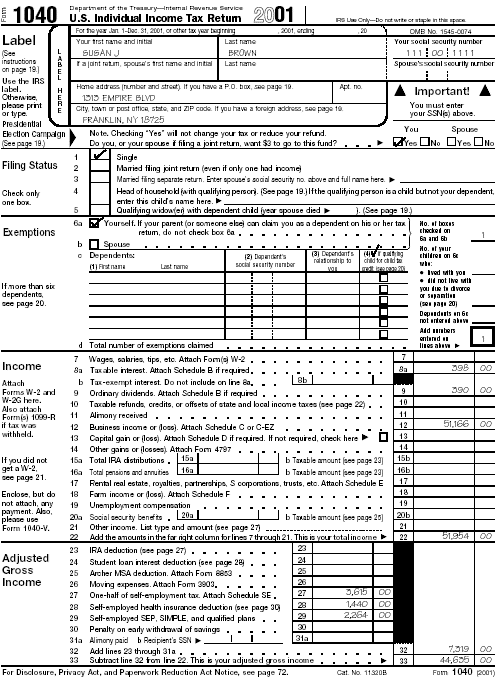
Page 1 of Form 1040 for Susan J. Brown
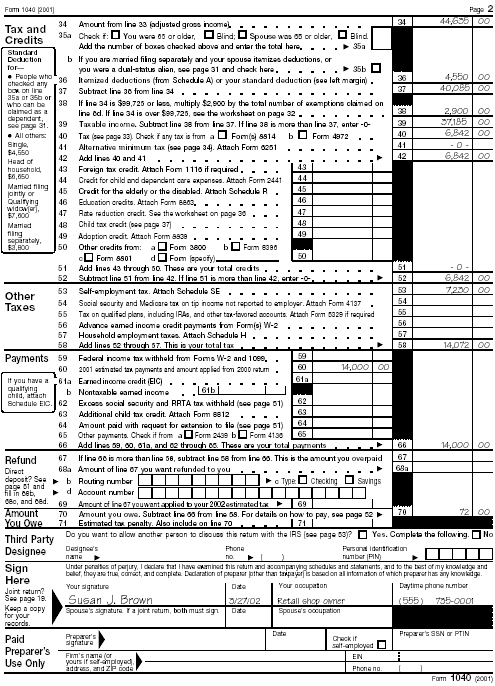
Page 2 of Form 1040 for Susan J. Brown
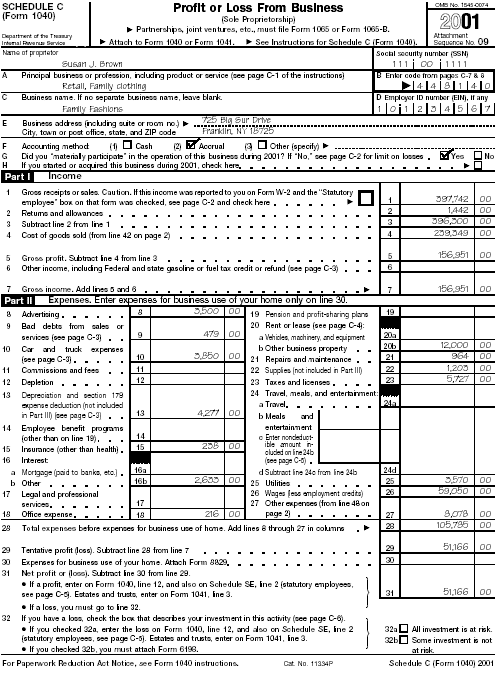
Page 1 of Schedule C (Form 1040) for Susan J. Brown
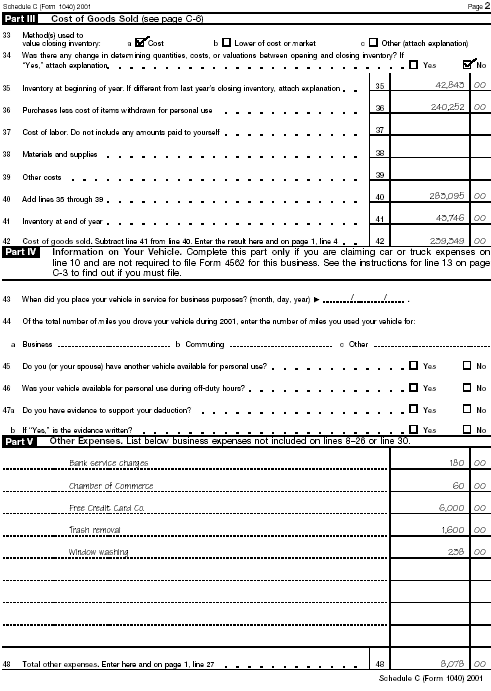
Page 2 of Schedule C (Form 1040) for Susan J. Brown
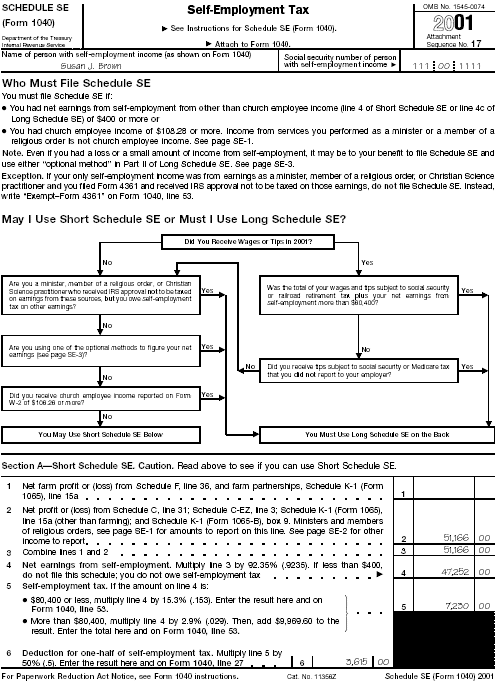
Page 1 of Schedule SE (Form 1040) for Susan J. Brown
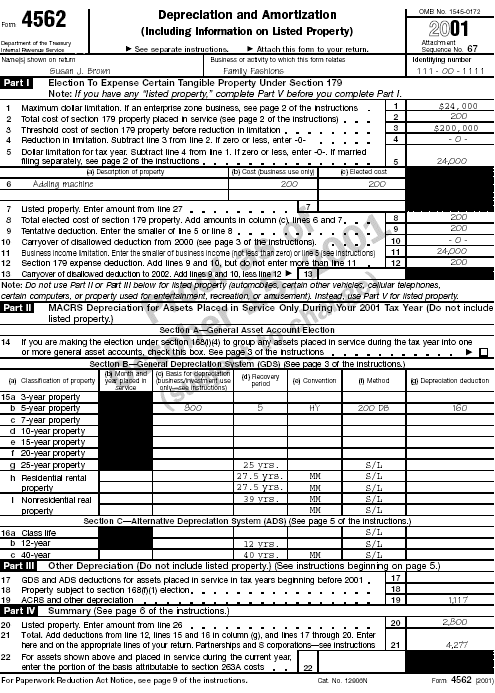
Page 1 of Form 4562 for Susan J. Brown
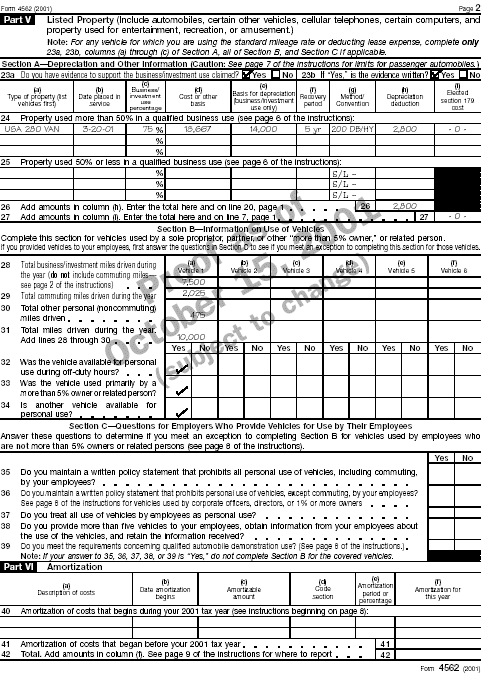
Page 2 of Form 4562 for Susan J. Brown
Preparing the Return for Stanley Price
Stanley Price owns and operates Stan's Barber Shop. He has been in business for 32 years. Stanley uses the cash method of accounting and files his return on a calendar year basis.
Schedule C-EZ
Stanley uses Schedule C-EZ to report the net profit from his business because he meets all of the requirements listed in Part I of the schedule. Stanley enters his name and social security number at the top of the schedule.
Part I-General Information
Stanley fills out Part I as follows:
Line A. He enters his principal business.
Line B. He enters 812111, which is the 6-digit business code for a barber shop. He found the code on page C-8 of the instructions for Schedule C. Stanley locates the major business category that describes his business. He reads down the items under Other Services to find 812111 - Barber shops.
Line C. He enters the name of his business - Stan's Barber Shop.
Line D. Stanley leaves this line blank. He does not have an employer identification number (EIN) because he is not required to have one. For information about EINs, see Identification Numbers in chapter 1.
Line E. He enters his business address.
Part II-Figure Your Net Profit
Stanley fills out Part II as follows:
Line 1-Gross receipts. Stanley enters his gross receipts from cutting hair. They include the amounts he charged for haircuts and all the tips received from his customers. The total for the year was $27,000.
Line 2-Total expenses. Stanley enters his expenses for the year. They total $2,330 and consist of the following:
- Advertising in the local newspaper - $145
- Supplies - $475
- Business licenses - $150
- Utilities (electricity and water) - $360
- Rent - $1,200
Line 3-Net profit. Stanley subtracts his total expenses ($2,330) from his gross receipts ($27,000) to get his net profit of $24,670. He enters his net profit here, on line 12 of Form 1040, and on line 2, Section A of Schedule SE (Form 1040).
Part III-Information on Your Vehicle
Stanley leaves this part blank because he is not deducting car or truck expenses.
Schedule SE - Self-Employment Tax
After Stanley prepares Schedule C-EZ, he fills out Schedule SE. He starts by entering his name and social security number at the top of the schedule. Then he reads the chart on page 1 of the schedule, which tells him he can use Section A - Short Schedule SE to figure his self-employment tax. He fills out the following lines in Section A.
Lines 2 and 3. He enters $24,670. This is his net profit from line 3 of Schedule C-EZ.
Line 4. He multiplies $24,670 by .9235 to get his net earnings from self-employment ($22,783). This is his net profit subject to self-employment tax.
Line 5. Because the amount on line 4 is less than $84,900, Stanley multiplies the amount on line 4 ($22,783) by .153 to get his self-employment tax of $3,486. He enters that amount here and on line 56 of Form 1040.
Line 6. He multiplies the amount on line 5 by .5 to get his deduction for one-half of self-employment tax of $1,743. He enters that amount here and on line 29 of Form 1040.
Form 1040
Stanley fills out Form 1040 as follows:
Name, address, and social security number. Stanley enters his name, home address, and social security number.
Presidential election campaign fund. Stanley chooses to have $3 go to this fund. He checks the box under Yes.
Line 1. Stanley checks the box on this line because he is filing as single.
Lines 6a and 6d. Stanley claims an exemption for himself. He checks the box next to Yourself and enters 1 in the far right-hand entry space. He also enters 1 in the box on line 6d.
Line 8a. Stanley enters $295 of taxable interest credited to his personal savings account for the year.
Line 9. Stanley enters $145 of dividends he received from ABC Corporation.
Line 12. He enters his business net profit of $24,670 from line 3 of Schedule C-EZ.
Line 22. Stanley adds the amounts on lines 7 through 21 and enters the total, $25,110.
Line 24. Stanley enters the $2,000 contribution he made for the year to his individual retirement arrangement (IRA). According to the Form 1040 instructions, he can deduct this amount.
Line 29. Stanley enters one-half of his self-employment tax. He got this amount from line 6 in Section A of Schedule SE.
Line 34. Stanley adds the amounts on lines 23 through 33a and enters the total, $3,743.
Line 35. Stanley subtracts the amount on line 34 from the amount on line 22 to arrive at his adjusted gross income, $21,367. He also enters this amount on line 36.
Line 38. He enters $4,700. This is the standard deduction for a single filer.
Line 39. Stanley subtracts line 38 from line 36 to get $16,667.
Line 40. He multiplies $3,000 by the number of exemptions claimed on line 6d to get his total exemptions, $3,000.
Line 41. Stanley subtracts line 40 from line 39 to get his taxable income, $13,667.
Line 42. Stanley uses the Tax Table in the Form 1040 instructions to figure his income tax. In the Tax Table he looks for the income bracket that includes $13,667. He finds the bracket for incomes of at least $13,650, but less than $13,700 and sees that the tax for a person filing as single is $1,751. He enters this amount here.
Lines 43 and 44. Because he does not owe alternative minimum tax, he enters -0- on line 43 and $1,751 on line 44.
Lines 54 and 55. Because Stanley does not have any of the credits listed on lines 45 through 53, he enters -0- on line 54 and $1,751 on line 55.
Line 56. He enters $3,486 from line 5 in Section A of Schedule SE.
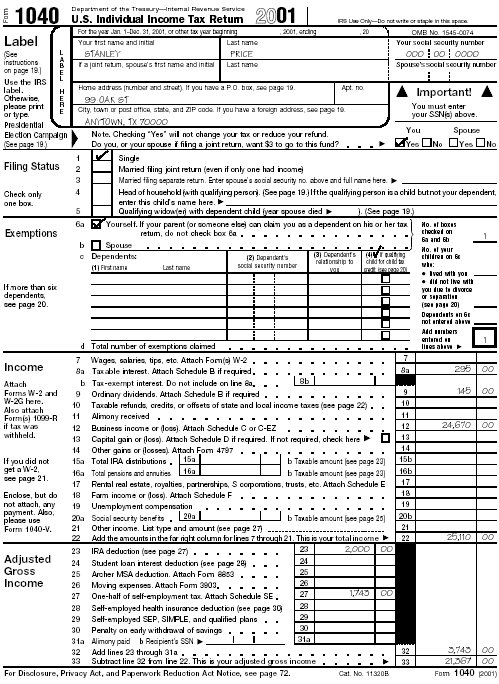
Page 1 of Form 1040 for Stanley Price
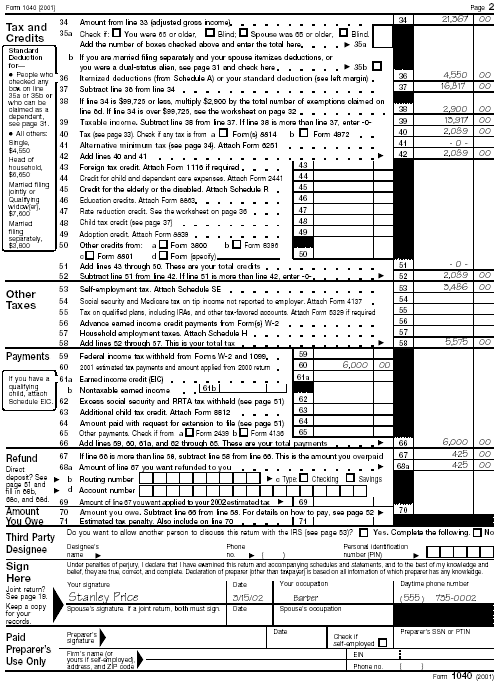
Page 2 of Form 1040 for Stanley Price
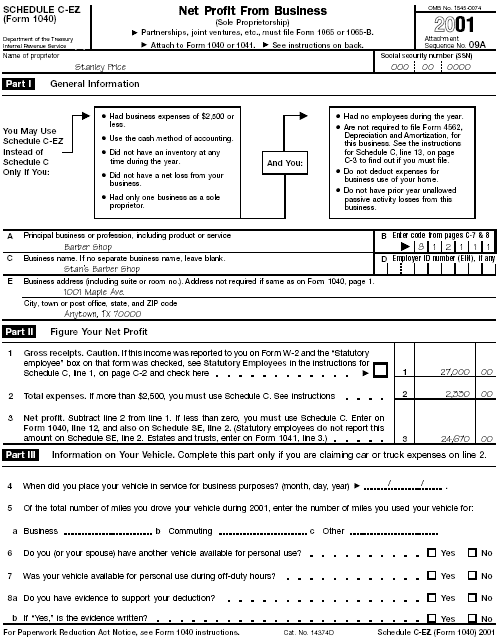
Page 1 of Schedule C-EZ (Form 1040) for Stanley Price
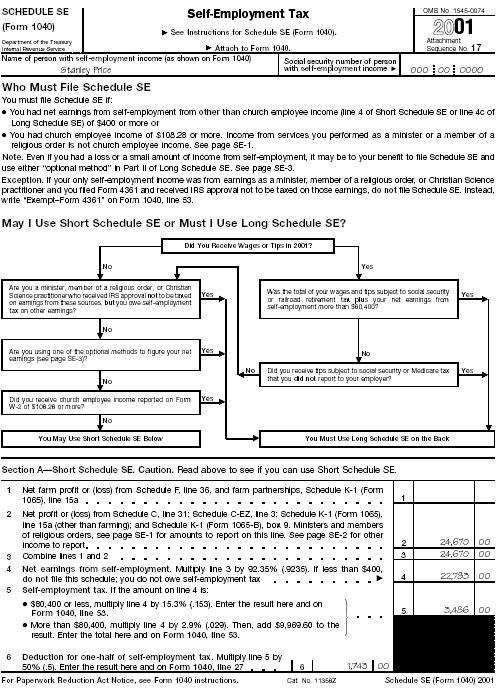
Page 1 of Schedule SE (Form 1040) for Stanley Price
Line 61. Stanley adds the amounts on lines 55 through 60 and enters the total, $5,237.
Line 63. He enters $6,000 of estimated tax payments he made for the year.
Line 69. He enters $6,000.
Lines 70 and 71a. Stanley subtracts line 61 from line 69 to arrive at the amount he overpaid, $763. He wants this amount refunded to him so he enters it on line 71a. The IRS will send him a check for this amount provided he owes no other taxes, child support, spousal support, or certain other federal nontax debt. If Stanley wanted the refund deposited directly into his checking or savings account, he would have had to complete lines 71b, c, and d.
Signing and assembling the return. He signs his name and enters the date signed, his occupation, and a daytime telephone number. He assembles his original Form 1040 and Schedules C-EZ and SE in that order. (See Attachment Sequence Number in the upper right corner of each schedule or form.) Then he makes a copy of the return for his records. Finally, he mails it to the IRS.
Previous | First | Next
Publication Index | 2002 Tax Help Archives | Tax Help Archives | Home

 Printer Friendly Page
Printer Friendly Page